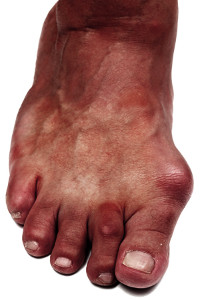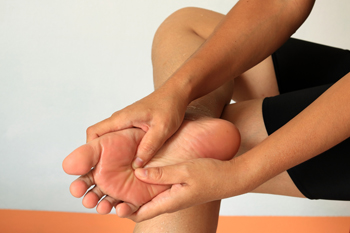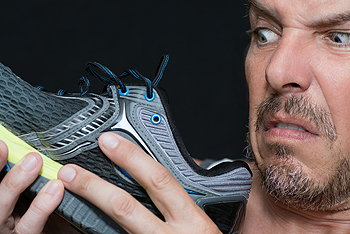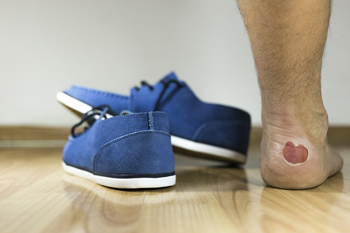 If you enjoy walking and exercising, the pain of a bunion may cause considerable interference in your enjoyment of these activities. They most commonly form at the base and side of the big toe, and could become worse by wearing shoes that do not fit properly. These types of shoes include those that have a narrow toe area, which does not have adequate room for the toes to move about in. When the bunion begins to form, the majority of shoes do not have ample room to accommodate the bony protrusion, and this may result in pain and stiffness emanating from the joint and surrounding areas. There are several ways to properly treat a bunion, and it typically begins with wearing the correct shoes that may eliminate painful pressure on the toe. If you feel you have developed a bunion, it’s suggested to consult with a podiatrist so the correct course of treatment can commence.
If you enjoy walking and exercising, the pain of a bunion may cause considerable interference in your enjoyment of these activities. They most commonly form at the base and side of the big toe, and could become worse by wearing shoes that do not fit properly. These types of shoes include those that have a narrow toe area, which does not have adequate room for the toes to move about in. When the bunion begins to form, the majority of shoes do not have ample room to accommodate the bony protrusion, and this may result in pain and stiffness emanating from the joint and surrounding areas. There are several ways to properly treat a bunion, and it typically begins with wearing the correct shoes that may eliminate painful pressure on the toe. If you feel you have developed a bunion, it’s suggested to consult with a podiatrist so the correct course of treatment can commence.
If you are suffering from bunion pain, contact Brent Harwood, DPM of Southeast Podiatry. Our doctor can provide the care you need to keep you pain-free and on your feet.
What Is a Bunion?
Bunions are painful bony bumps that usually develop on the inside of the foot at the joint of the big toe. As the deformity increases over time, it may become painful to walk and wear shoes. Women are more likely to exacerbate existing bunions since they often wear tight, narrow shoes that shift their toes together. Bunion pain can be relieved by wearing wider shoes with enough room for the toes.
Causes
Symptoms
In order to diagnose your bunion, your podiatrist may ask about your medical history, symptoms, and general health. Your doctor might also order an x-ray to take a closer look at your feet. Nonsurgical treatment options include orthotics, padding, icing, changes in footwear, and medication. If nonsurgical treatments don’t alleviate your bunion pain, surgery may be necessary.
If you have any questions, please feel free to contact one of our offices located in Fairhope, Brewton, and Atmore, AL . We offer the newest diagnostic and treatment technologies for all your foot care needs.
Read more about Bunions Severe pain and discomfort that is felt on the ball of the foot may be indicative of a condition that is referred to as Morton’s neuroma. It is often the result of nerves that become inflamed between the third and fourth toes, and is often known as a intermetatarsal neuroma. A major symptom of this condition is pain that is experienced on the bottom of the foot, possibly causing difficulty in walking. Many people may generally feel a tingling sensation in addition to feeling a burning sensitivity in the ball of the foot. A common reason for this condition to occur may be choosing to wear shoes that do not fit properly, and this may possibly cause the nerves in the foot to become irritated and inflamed. Additionally, performing certain activities may play a significant role in the formation of Morton’s neuroma. It’s advised to counsel with a podiatrist for proper treatments if you are afflicted with this ailment
Severe pain and discomfort that is felt on the ball of the foot may be indicative of a condition that is referred to as Morton’s neuroma. It is often the result of nerves that become inflamed between the third and fourth toes, and is often known as a intermetatarsal neuroma. A major symptom of this condition is pain that is experienced on the bottom of the foot, possibly causing difficulty in walking. Many people may generally feel a tingling sensation in addition to feeling a burning sensitivity in the ball of the foot. A common reason for this condition to occur may be choosing to wear shoes that do not fit properly, and this may possibly cause the nerves in the foot to become irritated and inflamed. Additionally, performing certain activities may play a significant role in the formation of Morton’s neuroma. It’s advised to counsel with a podiatrist for proper treatments if you are afflicted with this ailment
Morton’s neuroma is a very uncomfortable condition to live with. If you think you have Morton’s neuroma, contact Brent Harwood, DPM of Southeast Podiatry. Our doctor will attend to all of your foot care needs and answer any of your related questions.
Morton’s Neuroma
Morton's neuroma is a painful foot condition that commonly affects the areas between the second and third or third and fourth toe, although other areas of the foot are also susceptible. Morton’s neuroma is caused by an inflamed nerve in the foot that is being squeezed and aggravated by surrounding bones.
What Increases the Chances of Having Morton’s Neuroma?
Morton’s neuroma is a very treatable condition. Orthotics and shoe inserts can often be used to alleviate the pain on the forefront of the feet. In more severe cases, corticosteroids can also be prescribed. In order to figure out the best treatment for your neuroma, it’s recommended to seek the care of a podiatrist who can diagnose your condition and provide different treatment options.
If you have any questions, please feel free to contact one of our offices located in Fairhope, Brewton, and Atmore, AL . We offer the newest diagnostic and treatment technologies for all your foot care needs.
Read more about Morton's Neuroma Hyperhidrosis is a medical condition that causes the body to sweat excessively. Common areas that are affected by this condition include the hands, feet, and underarms. The proper term for hyperhidrosis that only occurs on the feet is plantar hyperhidrosis. Although the condition isn’t life threatening, it can cause embarrassment and distress for those who deal with it. Each foot contains approximately 250,000 eccrine sweat glands that are responsible for producing half a pint of sweat each day. People with plantar hyperhidrosis usually have to change their socks several times per day. Although the exact cause of the condition is unknown, some doctors believe it is caused by overactivity of the sympathetic nerve. Others, however, believe hyperhidrosis is solely a genetic condition. Hyperhidrosis is a treatable condition, and if you are looking to explore your treatment options, you should speak with your podiatrist today.
Hyperhidrosis is a medical condition that causes the body to sweat excessively. Common areas that are affected by this condition include the hands, feet, and underarms. The proper term for hyperhidrosis that only occurs on the feet is plantar hyperhidrosis. Although the condition isn’t life threatening, it can cause embarrassment and distress for those who deal with it. Each foot contains approximately 250,000 eccrine sweat glands that are responsible for producing half a pint of sweat each day. People with plantar hyperhidrosis usually have to change their socks several times per day. Although the exact cause of the condition is unknown, some doctors believe it is caused by overactivity of the sympathetic nerve. Others, however, believe hyperhidrosis is solely a genetic condition. Hyperhidrosis is a treatable condition, and if you are looking to explore your treatment options, you should speak with your podiatrist today.
If you are suffering from hyperhidrosis contact Brent Harwood, DPM of Southeast Podiatry. Our doctor can provide the care you need to attend to all of your foot care needs.
Hyperhidrosis of the Feet
Hyperhidrosis is a rare disorder that can cause people to have excessive sweating of their feet. This can usually occur all on its own without rigorous activity involved. People who suffer from hyperhidrosis may also experience sweaty palms.
Although it is said that sweating is a healthy process meant to cool down the body temperature and to maintain a proper internal temperature, hyperhidrosis may prove to be a huge hindrance on a person’s everyday life.
Plantar hyperhidrosis is considered to be the main form of hyperhidrosis. Secondary hyperhidrosis can refer to sweating that occurs in areas other than the feet or hands and armpits. Often this may be a sign of it being related to another medical condition such as menopause, hyperthyroidism and even Parkinson’s disease.
In order to alleviate this condition, it is important to see your doctor so that they may prescribe the necessary medications so that you can begin to live a normal life again. If this is left untreated, it is said that it will persist throughout an individual’s life.
A last resort approach would be surgery, but it is best to speak with your doctor to find out what may be the best treatment for you.
If you have any questions please feel free to contact one of our offices located in Fairhope, Brewton, and Atmore, AL . We offer the newest diagnostic and treatment technologies for all your foot care needs.
Read more about Hyperhidrosis of the Feet If you’ve worn shoes that fit incorrectly or are too tight, the friction that occurs may cause blisters to form on the toes and feet. They are observed as small areas that are filled with fluid, which is often seen in the top layer of the skin. The blister serves as a defense mechanism to protect the skin against germs and infections from entering the body, as a result of the skin disintegrating from excess pressure. There may be many causes of blisters, including sunburn, frostbite, or a skin condition such as dermatitis. Some people may find that insect bites may be a cause of blisters, in addition to having an allergic reaction to specific chemicals. Research has shown the importance of leaving the bister alone until it can dissolve naturally, which generally occurs when the skin is fully healed. Preventative measures can be taken by ceasing to wear the shoes or stopping the activity that caused the blisters. For severe blisters on the feet, please speak with a podiatrist as quickly as possible to learn how they can be treated properly.
If you’ve worn shoes that fit incorrectly or are too tight, the friction that occurs may cause blisters to form on the toes and feet. They are observed as small areas that are filled with fluid, which is often seen in the top layer of the skin. The blister serves as a defense mechanism to protect the skin against germs and infections from entering the body, as a result of the skin disintegrating from excess pressure. There may be many causes of blisters, including sunburn, frostbite, or a skin condition such as dermatitis. Some people may find that insect bites may be a cause of blisters, in addition to having an allergic reaction to specific chemicals. Research has shown the importance of leaving the bister alone until it can dissolve naturally, which generally occurs when the skin is fully healed. Preventative measures can be taken by ceasing to wear the shoes or stopping the activity that caused the blisters. For severe blisters on the feet, please speak with a podiatrist as quickly as possible to learn how they can be treated properly.
Blisters may appear as a single bubble or in a cluster. They can cause a lot of pain and may be filled with pus, blood, or watery serum. If your feet are hurting, contact Brent Harwood, DPM of Southeast Podiatry. Our doctor can provide the care you need to keep you pain-free and on your feet.
Foot Blisters
Foot blisters are often the result of friction. This happens due to the constant rubbing from shoes, which can lead to pain.
What Are Foot Blisters?
A foot blister is a small fluid-filled pocket that forms on the upper-most layer of the skin. Blisters are filled with clear fluid and can lead to blood drainage or pus if the area becomes infected.
Symptoms
(Blister symptoms may vary depending on what is causing them)
Prevention & Treatment
In order to prevent blisters, you should be sure to wear comfortable shoes with socks that cushion your feet and absorb sweat. Breaking a blister open may increase your chances of developing an infection. However, if your blister breaks, you should wash the area with soap and water immediately and then apply a bandage to the affected area. If your blisters cause severe pain it is important that you call your podiatrist right away.
If you have any questions, please feel free to contact one of our offices located in Fairhope, Brewton, and Atmore, AL . We offer the newest diagnostic and treatment technologies for all your foot care needs.
Read more about Blisters